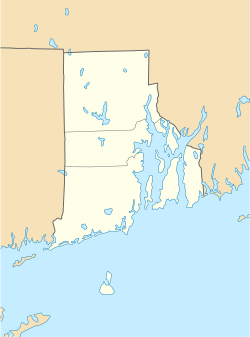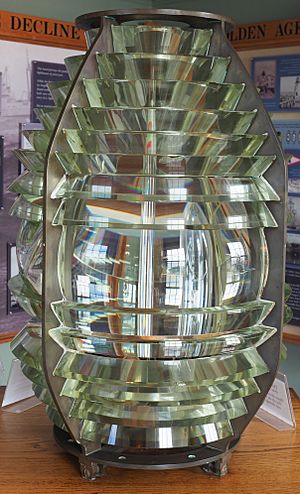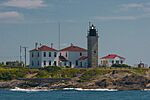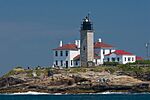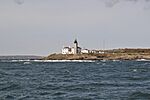Beavertail Lighthouse facts for kids
Quick facts for kids |
|
|
Beavertail Light
|
|
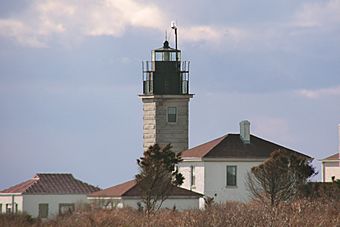 |
|
| Nearest city | Jamestown, RI |
|---|---|
| Area | 4 acres (1.6 ha) |
| Built | 1856 |
| MPS | Lighthouses of Rhode Island TR (AD) |
| NRHP reference No. | 77000024 |
| Added to NRHP | December 12, 1977 |
Beavertail Lighthouse is a famous landmark in Rhode Island. It was built in 1856 and helps guide ships into Narragansett Bay. This tall lighthouse stands on the very southern tip of Conanicut Island in the town of Jamestown, Rhode Island. It's located inside Beavertail State Park, a beautiful area where beacons have stood for hundreds of years. The light helps boats navigate the East Passage, which is the water channel between Conanicut Island and Newport, Rhode Island. From Beavertail Lighthouse, you can also see other lighthouses like Castle Hill Lighthouse, Point Judith Light, and Rose Island Light.
Contents
History of Beavertail Lighthouse
Early Beacons and First Lighthouse
Records from the town of Jamestown show that there was a beacon here as early as 1712. A watch house was also mentioned in 1705. In 1749, a wooden tower was built. This light became the third lighthouse ever built in the Thirteen Colonies, which later became the United States. It was known as "Newport Light." Back then, a fire was lit at the top of the tower to guide ships.
Just four years later, in 1753, the wooden lighthouse burned down. It was quickly replaced by a stronger stone tower.
Revolutionary War and Rebuilding
During the American Revolutionary War, British sailors were leaving Newport in 1779. As they left, they caused a lot of damage, including burning down the Beavertail Lighthouse. They also took away the special parts that made the light work. This left the lighthouse dark for the rest of the war.
The Current Lighthouse and New Technology
The lighthouse you see today was built in 1856. It's made of strong granite and stands 64 feet tall from the ground to its light. A special type of lens, called a Fresnel lens, was installed. This lens made the light much brighter and easier to see. For the next 40 years, many tests were done at Beavertail to improve fog signals, which are sounds that help ships in foggy weather. In 1898, more living space was added for an assistant lighthouse keeper. This person helped the main keeper with tasks like managing the fog signals.
The 1938 Hurricane and Modern Times
A very powerful storm, the 1938 New England hurricane, hit the area in 1938. The storm destroyed the building that held the fog whistle. This destruction actually revealed the original base of the first 1749 lighthouse, which is about 100 feet from the current tower.
Sadly, during this hurricane, Whale Rock Lighthouse and its keeper, Walter Eberle, were swept away into Narragansett Bay. Mr. Eberle's body was never found.
In 1939, the US Coast Guard took over managing all lighthouses and navigation aids in the United States. Beavertail Lighthouse became automated in 1989. This means that machines now operate the light, so a keeper no longer needs to live there.
The lighthouse building was repaired and opened to the public in 1989. This was thanks to a team effort by the US Coast Guard, Rhode Island Parks Management, the Rhode Island Department of Environmental Management, and the town of Jamestown. In 1993, the Beavertail Lighthouse Museum Association (BLMA) was created. They now run the Beavertail Lighthouse Museum, which is located in the assistant keeper's old house. The museum has a Fresnel lens and tells the story of many Rhode Island lighthouses.
See also
Gallery


